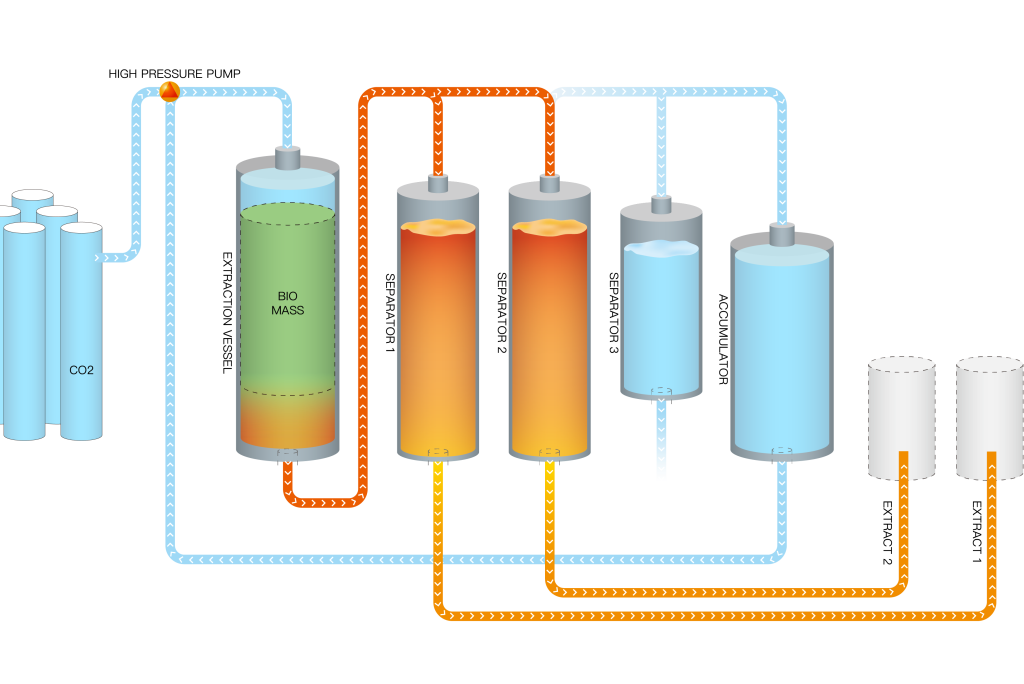What is flaxseed oil
Flax is an annual herb of the flax genus Linaceae.
Flaxseed is the seed of flax. It is flat, soft, and slightly hooked. It mainly contains nutrients such as cellulose, fat, protein, and carbohydrates. It is also rich in α-linolenic acid and linoleic acid. “A treasure house of fatty acids” has the effects of preventing cardiovascular diseases, preventing Alzheimer’s disease, and lowering cholesterol in medicine.
Alpha-linolenic acid is an essential fatty acid for the human body. Alpha-linolenic acid has many physiological activities such as antioxidant, anti-inflammatory, prevention of cardiovascular and cerebrovascular diseases, treatment of diabetes, protection of eyesight, and improvement of memory. It is widely used in medicine, food and cosmetics, and other fields.
At present, α-linolenic acid cannot be synthesized artificially. It is mainly obtained from natural resources such as seed oil, beans, walnuts, and so on. The reported methods for the purification of α-linolenic acid include the urea inclusion method, low-temperature crystallization method, and molecular steaming method. And supercritical CO2 extraction method.
In this paper, flaxseed is used as the raw material, and the oil yield and the yield of α-linolenic acid are used as the inspection indicators. Single-factor experiments are used to study the effects of extraction pressure, extraction temperature, extraction time, and other factors on the extraction effect. Supercritical CO2 is selected. The technological conditions for extracting α-linolenic acid from flaxseed.

CO2 Extraction of Flaxseed Oil in 5 Steps
- Take an appropriate amount of flaxseed, crushed and sieved (40-60 mesh powder) for later use.
- In each experiment, accurately weigh 6g of flaxseed powder into the supercritical extraction kettle, and place the extraction kettle in the supercritical extraction thermostat.
- After the extraction temperature reaches the set value, open the CO2 inlet valve and gradually increase the pressure to the set value.
- After the extraction pressure is stable, open the CO2 outlet valve and adjust its flow rate to collect the product and start timing.
- After the CO2 extraction, the extract was weighed and the content of α-linolenic acid was determined.
3 key process data for linseed oil CO2 extraction
Extraction Pressure
Under the conditions of extraction temperature of 40°C, extraction time of 1h, and CO2 flow rate of 1.5l/min, different operating pressures (15MPa, 20MPa, 25MPa, 30MPa, 35MPa) were used in order to conduct experiments to investigate the effect of extraction pressure on extraction. The effect of the effect.
As the pressure increases, the oil yield and α-linolenic acid yield also increase. When the pressure changes between 15 and 25 MPa, the oil yield and α-linolenic acid yield change greatly; when the pressure changes between 25 and 35 MPa, the oil yield and α-linolenic acid yield change more slowly.
This is because when the temperature is constant, as the pressure increases, the density of the supercritical CO2 fluid will increase accordingly, so that the solubility of the extracted components will increase, and the oil yield and α-linolenic acid will increase. The rate increases with increasing pressure.
However, the solubility of supercritical CO2 fluid has a non-linear positive correlation with extraction pressure. When the extraction pressure is low, the density of supercritical CO2 fluid is more obviously affected by pressure. A slight increase in pressure results in a significant increase in density. The increase of the fluid directly causes the solubility of the extracted components to increase, so at low pressure, the oil yield and α-linolenic acid yield increase faster with the increase of pressure.
When the pressure continues to increase to a certain critical value, the growth rate of oil yield and a-linolenic acid yield obviously slows down. In addition, as the pressure increases, the requirements for instruments and equipment also increase, the manufacturing cost increases, and excessive operating pressure may bring hidden dangers to safe production. Comprehensive consideration, the appropriate extraction pressure is 30MPa.
Extraction Temprature
Under the conditions of extraction pressure of 25MPa, extraction time of 1h, and CO2 flow rate of 1.5l/min, different operating temperatures (35°C, 40°C, 45°C, 50°C, 55°C) are used in sequence Conduct experiments to investigate the effect of extraction temperature on the extraction effect
With the increase of temperature, the oil yield and the yield of a-linolenic acid first increase and then decrease, reaching the highest at 40°C. This is because as the temperature rises, the speed of molecular thermal motion will increase, and the probability of collisions between molecules will increase so that the chance of contact between the supercritical CO2 fluid and the components to be extracted increases, and the temperature rises to be extracted. The diffusion coefficient of the components increases and the mass transfer speed increases, which is beneficial to the extraction of the components.
However, the increase in temperature will also reduce the density of the supercritical CO2 fluid, and the solubility will decrease accordingly, and the extraction capacity will decrease, which will lead to a decrease of the oil yield and the yield of a-linolenic acid.
It can be seen that increasing the temperature will have two positive and negative effects on both the oil yield and the yield of a-linolenic acid, and there will be an equilibrium point, that is, the most suitable extraction temperature. In addition, the temperature damage to heat-sensitive substances and the need to protect the activity of the extracted substances must also be considered. Considering comprehensively, the appropriate extraction temperature is 40°C
Extraction Time
Under the conditions of extraction pressure of 25MPa, extraction temperature of 40°C, and CO2 flow rate of 1.5l/min, different extraction times (0.5h, 1h, 1.5h, 2h, 2.5h) were used in order to conduct experiments to investigate The effect of extraction time on the extraction effect,
Both the oil production rate and the α-linolenic acid yield increased with the continuation of time, but the growth rate gradually slowed down and stabilized after 1.5 hours.
In the initial stage of extraction, the content of extracted components in a-flaxseed is relatively high, so as time goes on, a-flaxseed oil is continuously extracted by supercritical CO2, that is, the oil yield and α-linolenic acid yield The rates are increasing. As the extraction process progresses, the content of extracted components in a-linseed becomes smaller and smaller, and the mass transfer driving force in the extraction process gradually decreases, so that the oil yield and the yield of α-linolenic acid increase. Slow down gradually.
After a long enough extraction time (1.5h), the mass transfer driving force in the extraction process approaches 0. At this time, the extracted components in a-linseed and supercritical CO2 tend to balance, and the oil yield is equal to α -The yield of linolenic acid basically no longer increases.
The optimization co2 extraction process
Through single factor experiments on extraction pressure, extraction temperature, extraction time, and other factors, the optimal process conditions are extraction pressure 30MPa, extraction temperature 40°C, and extraction time 2.0h.
Under this process condition, the oil yield and α- The yields of linolenic acid were 24.7% and 12.5% respectively. The verification experiment shows that the supercritical CO2 extraction process obtained in the experiment is stable and reliable, which can provide a reference for the improvement of the extraction process of a-linolenic acid in flaxseed.
5 Important Parameters for CO2 Extraction of Linseed Oil
- Extraction Pressure: 300 bar
- Extraction Temperature: 40°C
- Separation Pressure: 85 bar
- Separation Temperature: 50°C
- Extraction Time: 120
Benefits of CO2 Linseed Oil
- High in Omega-3 Fatty Acids: CO2-extracted Linseed Oil contains high levels of omega-3 fatty acids, which have been linked to a range of health benefits, such as reducing inflammation and improving heart health.
- Pure and Safe: The CO2 extraction method is a safe and effective way to extract Linseed Oil without the use of harsh solvents or chemicals. This ensures a pure, high-quality product that is safe for consumption.
- Rich in Nutrients: CO2-extracted Linseed Oil retains more of the natural nutrients than other extraction methods, making it a more desirable ingredient in health supplements and other products.
- Longer Shelf Life: CO2-extracted Linseed Oil has a longer shelf life than traditional Linseed Oil because it is less susceptible to oxidation and rancidity.
- Improved Taste: CO2-extracted Linseed Oil has a milder taste and aroma than traditional linseed oil, making it more palatable for use in a wide range of applications.
A comparison of CO2 Extraction and Traditional Extraction for extracting Linseed Oil
| Criteria | CO2 Extraction | Traditional Extraction |
|---|---|---|
| Safety | Non-toxic | Potentially toxic |
| Quality of Product | High quality | Lower quality |
| Nutrient Retention | Retains more nutrients | Can destroy some nutrients |
| Shelf Life | Longer shelf life | Shorter shelf life |
| Flavor | Milder taste and aroma | Strong, distinct flavor |
